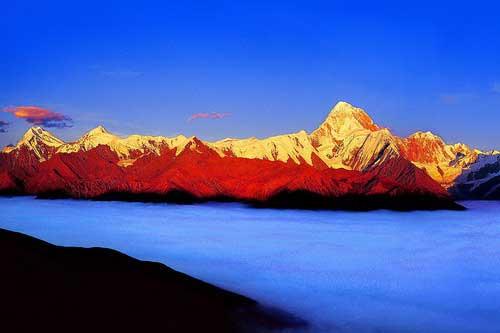The Minya Konka Mountain Scenic Area is located in the Luding, Kangding and Jiulong counties of Garze Tibetan Autonomous Prefecture. Taking the Minya Konka Mountains as its center, the scenic area consists of several parts including the Hailuo Valley, Mugecuo Lake, Wuxuhai Lake and the Minya Konka South Slope. It covers an area of about 10,000 square kilometers and is a national-level scenic and cultural area. Minya Konka Mountain is a residential region of minority nationalities, where tourists can see many temples of Tibetan Buddhism such as the Minya Konka Temple and Tagong Temple, and can also experience the colorful ethnic customs of the Tibetan, Yi and other nationalities.

Minya Konka Mountain Scenic Area
Minya Konka Mountain is a key scenic spot in the entire scenic area. It is about 200 kilometers long from south to north and covers an area of over 1,000 square kilometers. The highest peak of the mountain is 7,556 meters above sea level, the second highest in the world and the highest in Sichuan Province, and it is called the "King of Peaks". A Chinese mountaineering team once successfully reached the top of the peak in 1957. This peak and its sister peaks are all covered by ice and snow all year round, and there are 145 peaks that are between 5,000 and 6,000 meters above sea level. All the peaks are very beautiful and majestic.
In the Tibetan language, "Kon" means ice and snow and "Ka" means white. Therefore, “Konka” means white snow mountain. Minya Konka Mountain is renowned for its glaciers. It contains 159 modern glaciers, which cover over 390 square kilometers in total. The mountain is one of the earliest maritime glacier development regions in the world. The famous glaciers include the No. 1 Glacier of Hailuo Valley, the Gongba Glacier, Bawang Glacier, Yanzi Valley Glacier and Mizi Valley Glacier. The ice of the glaciers is usually between 150 and 300 meters thick and very beautiful. Due to the erosion by the glaciers, all the steep peaks have become pyramids in shape, standing upright and pointing to the sky.
Minya Konka Mountain is extremely high and covers seven climate zones, which are the subtropical zone, warm temperate zone, cold temperate zone, sub-frigid zone, frigid zone, super frigid zone, and the ice and snow zone from foot to top. The special geographic and climatic conditions cultivated multi-layer plant zones and distinctive natural landscapes. The peaks that are over 5,000 meters above sea level are all covered by snow all year round. The low-altitude slopes and mountain feet are covered by dense and thriving virgin forests which have almost never been devastated by human activities. The forests almost contain all the plant species that could grow in the zones from the subtropical zone to alpine frigid zone, including a lot of rare species. The mountain has over 4,480 plant species, of which, over 400 are national-level rare species. In the eastern river valleys, there are also many ancient “living fossil” plants growing. The mountain is also the home of over 400 animal species including 28 rare species that are under protection. It can be said that the mountain s a true kingdom of wild animals and plants.
A lot of beautiful plateau lakes are scattered in the scenic area including the renowned Mugecu Lake, Wuxuhai Lake, Renzhonghai Lake and Bawanghai Lake. Located on the mountain feet or surrounded by forests, the lakes all have crystal-clear water and keep their virginal and elegant appearances. Their beauty is astonishing.
